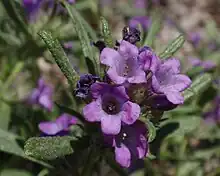| Eriodictyon lobbii | |
|---|---|
 | |
| Scientific classification | |
| Kingdom: | Plantae |
| Clade: | Tracheophytes |
| Clade: | Angiosperms |
| Clade: | Eudicots |
| Clade: | Asterids |
| Order: | Boraginales |
| Family: | Boraginaceae |
| Genus: | Eriodictyon |
| Species: | E. lobbii |
| Binomial name | |
| Eriodictyon lobbii (A.Gray) Greene | |
| Synonyms | |
| |
Eriodictyon lobbii is a species of flowering plant in the borage family known by the common names Lobb's fiddleleaf and matted yerba santa. It is native to the Sierra Nevada and southern Cascade Range chain in California and adjacent sections of Nevada and Oregon. It grows in high mountain habitat in dry areas on slopes and ridges.
Description
Eriodictyon lobbii is a rhizomatous perennial herb forming dense mats of glandular hairy to woolly herbage usually spreading more than a meter wide. The sticky, hairy oval leaves are up to six centimeters long, occurring alternately along the branching stems and in clusters at stem forks. The funnel-shaped flowers are just under a centimeter wide with five rounded lobes. They are deep pink to purple in color. The plant sends out wide root networks which can grow up to five meters in length per year and sprout new plants.[1]
Uses
The plant Eriodictyon lobbii has been recommended for use as groundcover in revegetation projects in its native mountain ranges.[1]
Taxonomy
This taxon has been variously treated as Nama lobbii, Conanthus lobbii, and Marilaunidium lobbii. The current treatment of Jepson eFlora regards this plant as Eriodictyon lobbii, based on molecular data provided on the Hydrophylloideae.[2][3]
References
- 1 2 Nord, E. C. and A. T. Leiser. Nama lobbii Gray. US Forest Service Woody Plant Seed Manual.
- ↑ Hannan, Gary L. (2016). "Eriodictyon lobbii". Jepson EFlora. Jepson Flora Project. Revision 4. Retrieved 22 December 2021.
- ↑ Ferguson, D. M. (1998). "Phylogenetic Analysis and Relationships in Hydrophyllaceae Based on ndhF Sequence Data". Systematic Botany. American Society of Plant Taxonomists. 23 (3): 253–268. doi:10.2307/2419504. JSTOR 2419504.
External links